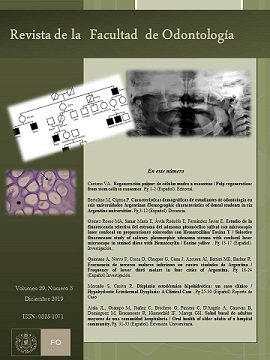Frequency of lower third molars in four cities of Argentina
Keywords:
Classification of Winter, Dental retention, Third molars, Prevalence, Panoramic X-ray.Abstract
The mandibular third molar is the last dental piece to erupt in the oral cavity, and has a high frequency of anomalies in its eruptive process. The Winter classification (1926), which relates the third molar with the longitudinal axis of the second molar, facilitates the diagnosis and its surgical approach. In this work we determined the frequency of the position of the lower third molars retained according to the Winter classification, in populations of the Argentine cities of Ushuaia (Province of Tierra del Fuego), Neuquén (Province of Neuquén), Selva (Province of Santiago del Estero) and Córdoba (Province of Córdoba) in order to know the statistics of the different geographical areas. A higher frequency of the vertical position was observed with 350 cases (51%), followed by the positions mesioangular (31%), horizontal (12%) and distoangular (6%). No inverted molars were recorded
Downloads
References
3. Almendros-Marqués N, Berini-Aytés L, Gay-Escoda C. Evaluation of intraexaminer and interexaminer agreement on classifying lower third molars according to the systems of Pell and Gregory and of Winter. J Oral Maxillofac Surg 2008;66(5):893-9.
4. Winter GB. Impacted mandibular third molars. St. Louis: Med Book, 1926.
5. Raspall Guillermo. Cirugía Oral e Implantología. Editorial Médica Panamericana. Año 2006; Capítulo 5: pág. 97-98.
6. Chicarelli da Silva, M, Estudio radiográfico de la prevalencia de impactaciones dentarias de terceros molares y sus respectivas posiciones, realizadas en el Sector de Radiología de la Clínica Odontológica de la Universidad Estatal de Maringá, en el período de 2009 a 2011. Clínica Estomatológica UEM, 2012.
7. Sagal López, M. Prevalencia de los terceros molares mediante radiografías panorámicas de alumnos de Odontología de la Universidad de Cataluña atendidos en el Servicio de Radiología Máxilofacial durante el periodo 2007- 2008. Tesis. UCE, 2009.
8. Tirado Delgado, P. Posición más frecuente de terceras molares mandibulares según la clasificación de Pell y Gregory con relación al factor sexo en el Hospital Central FAP. HMC FAP, 2015.
9. Llerena García, G, Arrascue Dulanto, M. Tiempo de cirugía efectiva en la extracción de los terceros molares realizadas por un cirujano oral y maxilofacial con experiencia. Revista Estomatológica Herediana [Internet]. 2006;16(1):40-45.
10. Valerio Rojas, H. Posiciones e inclusiones de terceros molares mandibulares en pacientes atendidos en la Clínica Estomatológica de la Universidad Inca Garcilaso de la Vega en el año 2011. Clínica Estomatológica UIGV, 2012.
11. Jáuregui M, Frecuencia y grado de apiñamiento anteroinferior en pacientes de 17 a 40 años con terceros molares en ambos sexos. Tesis. UNFV. 2000.
Published
Issue
Section
License
Aquellos autores/as que tengan publicaciones con esta revista, aceptan los términos siguientes:
- Los autores/as conservarán sus derechos de autor y garantizarán a la revista el derecho de primera publicación de su obra, el cuál estará simultáneamente sujeto a la Licencia de reconocimiento de Creative Commons que permite a terceros:
- Compartir — copiar y redistribuir el material en cualquier medio o formato
- La licenciante no puede revocar estas libertades en tanto usted siga los términos de la licencia
- Los autores/as podrán adoptar otros acuerdos de licencia no exclusiva de distribución de la versión de la obra publicada (p. ej.: depositarla en un archivo telemático institucional o publicarla en un volumen monográfico) siempre que se indique la publicación inicial en esta revista.
- Se permite y recomienda a los autores/as difundir su obra a través de Internet (p. ej.: en archivos telemáticos institucionales o en su página web) después del su publicación en la revista, lo cual puede producir intercambios interesantes y aumentar las citas de la obra publicada. (Véase El efecto del acceso abierto).

